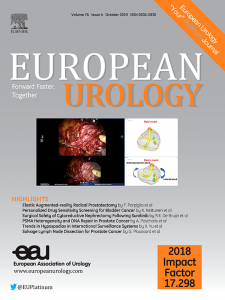PUrE随机对照试验1:输尿管软镜和体外冲击波碎石治疗≤10mm下极结石的临床和成本效益
IF 25.3
1区 医学
Q1 UROLOGY & NEPHROLOGY
引用次数: 0
摘要
背景和目的欧洲泌尿外科协会指南推荐体外冲击波碎石(ESWL)和柔性输尿管镜检查(FURS)是治疗下极肾结石(LPSs)同样合适的一线治疗选择。我们报告了一项实用的多中心、开放标签、优势随机对照试验(RCT),比较FURS与ESWL在生活质量、llp≤10 mm的临床和成本效益方面的差异,其中一项是经皮肾镜取石术、柔性输尿管镜和体外冲击波碎石术治疗下极肾结石研究(PUrE)的两项RCT之一,另一项是PUrE RCT 2,研究更大的结石。方法共有231例和230例患者随机分为FURS组和ESWL组。采用EQ-5D-5L问卷调查干预后12周的健康状况曲线下面积(AUC)。主要的经济结果是随机化后12个月每个质量调整生命年(QALY)的增量成本。FURS组(n = 164)和ESWL组(n = 188) 12周的平均健康状况auc分别为0.807(标准差[SD] 0.205)和0.826(标准差[SD] 0.207);组间差异为0.024(95%可信区间为-0.004,0.053),这是一个小的不显著差异,有利于FURS调整初始基线不平衡。FURS组结石完全清除率(72%)高于ESWL组(36%)。FURS和ESWL之间的增量成本效益比为65 163英镑,这意味着在每个QALY的阈值为2万英镑时,ESWL有99%的机会具有成本效益。spure RCT 1发现,对于≤10 mm的LPSs, FURS和ESWL在健康状况上没有差异,FURS导致更高的结石去除率。ESWL比FURS更具成本效益。本文章由计算机程序翻译,如有差异,请以英文原文为准。
The PUrE randomised controlled trial 1: Clinical and cost effectiveness of flexible ureterorenoscopy and extracorporeal shockwave lithotripsy for lower pole stones of ≤10 mm
Background and objective
The European Association of Urology guidelines recommend that extracorporeal shockwave lithotripsy (ESWL) and flexible ureterorenoscopy (FURS) are equally appropriate first-line treatment options for lower pole renal stones (LPSs). We report a pragmatic multicentre, open-label, superiority randomised controlled trial (RCT) comparing FURS versus ESWL for quality of life, and clinical and cost effectiveness for LPSs of ≤10 mm—one of two RCTs that were part of the Percutaneous nephrolithotomy, flexible Ureteroscopy and Extracorporeal shockwave lithotripsy for lower pole kidney stone study (PUrE), with the other PUrE RCT 2 investigating larger stones.Methods
In total, 231 and 230 patients were randomised to FURS and ESWL, respectively. The primary outcome was health status area under the curve (AUC) 12 wk after intervention using the EQ-5D-5L questionnaire. The primary economic outcome was the incremental cost per quality-adjusted life-year (QALY) gained at 12 mo after randomisation.Key findings and limitations
The mean health status AUCs over 12 wk were 0.807 (standard deviation [SD] 0.205) for FURS (n = 164) and 0.826 (SD 0.207) for ESWL (n = 188); the between-group difference was 0.024 (95% confidence interval –0.004, 0.053), a small nonsignificant difference in favour of FURS adjusted for an initial baseline imbalance. Complete stone clearance was higher with FURS (72%) than with ESWL (36%). The incremental cost-effectiveness ratio between FURS and ESWL was £65 163, meaning that at a threshold value of £20 000 per QALY, ESWL has a >99% chance of being cost effective.Conclusions and clinical implications
PUrE RCT 1 found that there was no evidence of a difference in health status between FURS and ESWL for LPSs of ≤10 mm, with FURS leading to a higher stone-free rate. ESWL was more cost effective than FURS.求助全文
通过发布文献求助,成功后即可免费获取论文全文。
去求助
来源期刊

European urology
医学-泌尿学与肾脏学
CiteScore
43.00
自引率
2.60%
发文量
1753
审稿时长
23 days
期刊介绍:
European Urology is a peer-reviewed journal that publishes original articles and reviews on a broad spectrum of urological issues. Covering topics such as oncology, impotence, infertility, pediatrics, lithiasis and endourology, the journal also highlights recent advances in techniques, instrumentation, surgery, and pediatric urology. This comprehensive approach provides readers with an in-depth guide to international developments in urology.
 求助内容:
求助内容: 应助结果提醒方式:
应助结果提醒方式:


